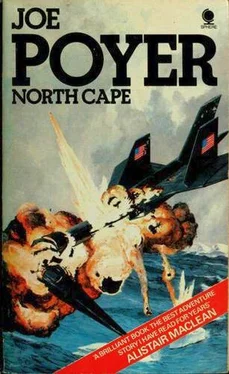The turbojet engine is the most efficient of all propulsion systems’ for speeds between Mach .9 and Mach 2.5, where fuel load, speed, range, and weight are the critical factors. Beyond Mach 2.5 and one hundred thousand feet, the ramjet becomes the most efficient Beyond 120,000 feet, where the air is too thin to support even the ramjet, the rocket engine, with its self-contained oxidizer, becomes the most efficient. To avoid Soviet antiaircraft missiles, the A-17 needed an altitude greater than 125,000 feet. Since the late 1950s, a combination of the three types of propulsive systems had been the research goal of aeronautical research laboratories all across the world. The approach finally adapted to the A-17 was the U. S. Air Force concept called the TURBO-RAM-ROCKET. Below eighty thousand feet and Mach 2.5, the twin power plants in the A-17 functioned as turbojets — air sucked in through the inlet and forced into a combustion chamber, where it mixed with fuel, burned fiercely and the hot gas was forced past a turbine and expelled from the nozzle. The turbine was in turn coupled to the compressor behind the air inlet to compress air and force it into the combustion chamber. An improvement was made on the basic system by adding another stage in front of the compressor assembly called a fan. The fan was just that. Huge blades, coupled to and spun by the turbine, pulled in far more air than the combustion process needed. The excess air was ducted out the side of the engine casing to add as much as 30 percent more thrust.
The turbofan, as it was properly called, was capable of pushing the A-17 to speeds above Mach 2.5. Depending upon the altitude and various atmospheric conditions that necessitated the change — somewhere above Mach 2.5 to 3 — the engine switched from the turbojet mode to ramjet. It was in this versatility that the twin engines differed radically from earlier jet aircraft engines. These assemblies are composed of a thick disk of high-strength steel alloy upon which are mounted cambered blades. The blades are twisted to assume an airfoil shape. In the usual turbojet engine, these blades are mounted rigidly. The turbine assembly is constructed the same way and the blades are made of various materials, selected to withstand temperatures in excess of 1600°F as the hot gases exit from the burner chamber. As a rule of thumb, Teleman had been taught, the hotter the temperature of the gases leaving the burner — the Turbine Inlet Temperature (TIT) — the greater the thrust developed by the engine. The A-17’s TIT was in excess of 3200 degrees.
To allow the power plant to enter the ramjet mode, the blades were mounted upon variable stator disks and could be turned edge-on to the airstream. In addition, the air inlet plug, a large rounded cone of metal mounted in front of the air inlet, could be moved forward to increase the air compression.
A ramjet engine works by ramming air into its combustion chamber at high speeds, where it is mixed with fuel and ignited by a glow plug. Because the ramjet must have a certain flow velocity of air before it will begin to operate, it usually must be carried aloft by another engine to the proper speed and altitude. But once in the thin reaches above eighty thousand feet, the two engines, now operating as ramjets, far surpass the potential and efficiency of the turbojet or turbofan.
A ramjet of this efficiency has a rather narrow operating “envelope.” When the air inlet plug is rammed forward to compress the air while the compressor blades are turned edge-on to — the airstream, a carefully designed tolerance between plug and inlet must be maintained to provide the maximum flow of air to the combustion chamber for the altitude and speed. This tolerance mechanically limits the altitudes and speed beyond which the ramjet may be operated in direct proportion to the growing lack of atmosphere. Beyond 170,000 feet, Teleman could elect, if the extra speed and altitude were needed, to go to the rocket mode.
Now, clamshell doors closed down the area ahead of the combustion chamber — or burner ring in the case of the A-17 engines — and liquid oxygen was fed directly into the burner ring to mix with the fuel — liquid hydrogen — thereby providing a rocket engine that was capable of taking the A-17 to Mach 5.9, only two thousand miles per hour less than would be needed to achieve sub-orbit. Teleman had never had occasion to use the rocket mode except on practice missions. It’ was a last-ditch stand when all else failed: The rocket mode could use six hours worth of carefully metered fuel in two minutes of burning time.
Most experienced military pilots who had received their training during the Vietnamese War were now edging toward the age where their efficiency was slowly being whittled away by the heavy demands placed upon them by their aircraft. Many had gone into the Vietnam War well past the age that a World War II flight surgeon would have considered them capable of controlling even the relatively slower and much less technically complicated fighter aircraft of that period. The younger pilots who had received their baptism of combat flying in the mid-1960s had left the service in droves at the end of the war to answer the lure of high salaries and lifetime sinecure in commercial airlines, which were expanding tremendously in the wake of the giant airliners, supersonic transports, and rapidly growing travel markets.
The human organism is still the most reliable of all mechanisms in spite of the strides that had been made in automation. Rather than load the aircraft down with servomechanisms and complicated gear to perform many of the tasks that the pilot could do, the designers had opted for the human factor.
The A-17 had been on the threshold of man’s ability to control under the difficult and microsecond decision points that had to be reached and gated properly when the aircraft was closing on its target at nearly four thousand miles an hour. The elapsed time from the moment a ground target — often less than a hundred feet across — came into sight until the A-17 had left it behind was often no more than four seconds. During this time, the information displayed on the screens had to be accepted, interpreted, a decision for action made, and the decision implemented; all with enough time remaining to allow the cameras and other recording devices to do their job.
Even in those instances where circumstances dictated that Teleman could loiter the aircraft over the target and select his objectives, someone had to decide what should be recorded, what must be searched for to make the picture complete, and handle the volumes of data that poured in, constantly interpreting, re-deciding and shifting objectives — and often targets. No computer could handle this job. Teleman was trained in the use of certain psychic energizer drugs of the amphetamine and lysergic acid families that could boost his body system output to fantastic heights in relation to normal physiological response. The LSD derivatives extended his powers of concentration and, through their hallucinogenic effect, made him feel that he was actually part of the aircraft. They also increased his comprehension and ability to deal with a multitude of facts in a very short time.
The amphetamines provided the same effect for his bodily responses, increasing his reaction time and slowing his time sense to compensate for the demands of the aircraft’s speed.
Teleman’s physiological and biochemical status was monitored constantly during the mission through a specially tailored system of instruments blended together to form the Physiological Control and Monitoring System. At the start of the mission, an intravenous catheter was inserted into the superior vena cava vein through a plug implanted surgically in his shoulder. A glass electrode was brought into intimate contact with his bloodstream at this nearest acceptable point to the heart. Through the electrode a series of minute pulses, set up by an electrochemical reaction with his blood, informed the computer continually of his body status. The computer was programed to receive inputs directly from various parts of the aircraft’s controlling instrumentation that, coupled with The in vivo status reports, determined the time and dosage of the drugs he received. If the instrumentation, directed by the flight plan or by instructions from Teleman, called for a state of physiologically alert and expanded consciousness, proper drugs were fed into his bloodstream through the catheter and his body responded accordingly. Because of the duration of the flights, often lasting six to seven days, when Teleman was not needed to respond to specific tasks, the computer instructed the PCMS to feed in barbiturate derivatives and he slept. Teleman had once calculated that at least 65 percent of all of his missions were spent sleeping. Although great pains had been taken to develop a high tolerance in Teleman to the drugs he was constantly being infused with, he was thoroughly poisoned by the end of a mission.
Читать дальше












